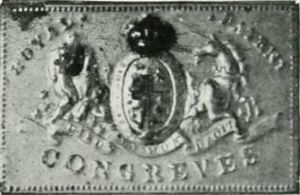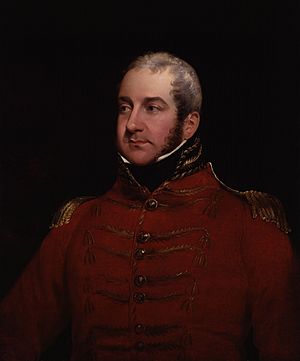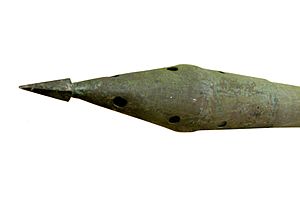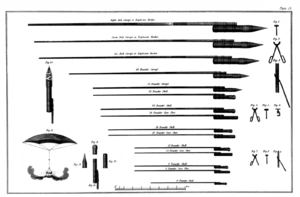Sir William Congreve, 2nd Baronet facts for kids
Sir William Congreve, 2nd Baronet (born May 20, 1772 – died May 16, 1828) was a British officer, politician, publisher, and inventor. He is most famous for creating and using Congreve rockets. These rockets were very important during the Napoleonic Wars. Congreve was a true pioneer in the world of rocket artillery.
Contents
Sir William Congreve's Life
Early Life and Education
William Congreve was born in Kent, England. He was the oldest son of Rebecca Elmston and Lieutenant General Sir William Congreve, 1st Baronet. His father was in charge of the Royal Laboratories at the Royal Arsenal.
Young William went to schools in Hackney, Wolverhampton, and Kent. Later, he studied law at Trinity College, Cambridge. He earned his first degree in 1793 and a master's degree in 1796. In 1814, he took over his father's title, becoming the second Baronet Congreve.
Career and Public Service
In 1803, Congreve joined the London and Westminster Light Horse as a volunteer. He also ran a newspaper called the Royal Standard and Political Register. This newspaper supported the government.
After some legal trouble with his newspaper in 1804, Congreve stopped publishing. He then focused on inventing. He started experimenting with rockets at Woolwich, even paying for the early tests himself. In 1814, he became the comptroller of the Royal Laboratory at Woolwich, just like his father had been.
Congreve received several honors for his work. He was made a lieutenant colonel in the Hanoverian army's artillery in 1811. He later became a major general in the same army. He also became a Fellow of the Royal Society that year. He received awards like the Order of St. George and the Knight Commander of the Royal Guelphic Order. In 1821, the King of Sweden gave him the Order of the Sword.
He was good friends with the Prince Regent, who later became King George IV. The Prince Regent supported Congreve's rocket projects. Congreve served as an equerry (an officer who attends a royal person) in his household from 1811.
Political Life and Later Years
In 1812, Congreve became a Member of Parliament (MP) for Gatton. He later became the MP for Plymouth in 1818 and held that seat until his death.
In December 1824, he married Isabella Carvalho in Prussia. She was a young woman of Portuguese descent. They had two sons and one daughter.
In 1824, Congreve became the general manager of a large company. This company, the English Association for Gas Lighting on the Continent, provided gas for cities in Europe, including Berlin. He also became a businessman, leading several other companies.
William Congreve died in Toulouse, France, in May 1828, when he was 55 years old. He was buried there in the Protestant and Jewish cemetery.

Interestingly, a type of friction match called "Congreaves" was named after him. However, he was not involved in inventing or making them.
Congreve Rockets
The Start of Military Rockets
The first iron-cased rockets used in war were the Mysorean rockets. These were used by Hyder Ali and his son Tipu Sultan in India. They used them against the British East India Company's forces starting in 1780. The British saw these rockets in battles like Seringapatam in 1792 and 1799.
The British learned about these rockets and started their own rocket research in 1801. They even brought some rocket parts from Mysore to Britain to study them. William Congreve led this important research at the Woolwich Arsenal. He was told that the British had suffered more from these rockets than from any other weapon in India. One person even told him that a single rocket had killed three men.
Some people have suggested that Congreve might have gotten ideas from rockets made by Robert Emmet in 1803. However, it's more likely that Congreve used the knowledge gained from the Indian rockets. The British had been exposed to Indian rockets since 1780. Also, many unused rockets and their building tools fell into British hands in 1799, four years before Emmet's rockets.
Rockets in Battle
Congreve first showed off his solid fuel rockets in 1805. He felt his rockets were ready for use. The Royal Navy used them in two attacks on the French fleet at Boulogne, France, in 1805 and 1806.
In 1807, Congreve and his team were at the Bombardment of Copenhagen. About 300 rockets were fired, which helped set the city on fire.
Congreve rockets were used successfully for the rest of the Napoleonic Wars. One of their most important uses was at the Battle of Leipzig in 1813. The famous line "the rockets' red glare" in the American national anthem describes these rockets being fired at Fort McHenry during the War of 1812.
By 1814, the British army had special Rocket Troops. Congreve rockets remained in use until the 1850s. Congreve also organized amazing firework displays in London. These were for the peace celebration in 1814 and for King George IV's coronation in 1821.
Other Inventions
Besides his famous rockets, Congreve was a very busy inventor throughout his life. He registered 18 patents in total, with two of them being for rockets.
Some of his other inventions included:
- A special mount for guns to handle their recoil (the kickback when fired).
- A time-fuze for explosives.
- A parachute attachment for rockets.
- A hydropneumatic canal lock and sluice (a gate to control water flow) in 1813. One was installed in north London.
- A process for colour printing in 1821, which became popular in Germany.
- A new type of steam engine.
- A way to reduce smoke from factories, which was used at the Royal Laboratory.
He also patented a unique Congreve clock. In this clock, time was measured by a ball rolling along a zig-zag path on a sloped surface. He also worked on ideas for protecting buildings from fire, combining metals, and creating unforgeable bank note paper. Other patents included a method for killing whales with rockets, better ways to make gunpowder, and improvements for fireworks and gas meters.
Congreve even tried to invent a perpetual motion machine. This machine was supposed to move forever without needing any energy. His idea involved an endless band of sponge and weights that would use capillary action to raise water. He believed this would create a continuous movement. However, like all perpetual motion ideas, it did not work because it went against the laws of physics.
See also




